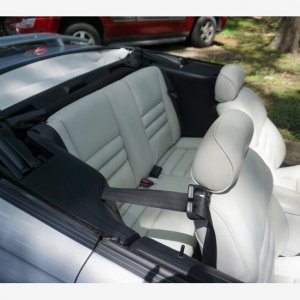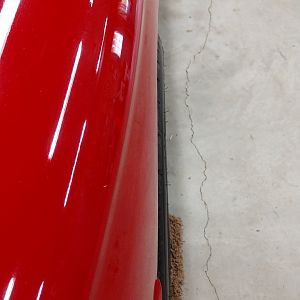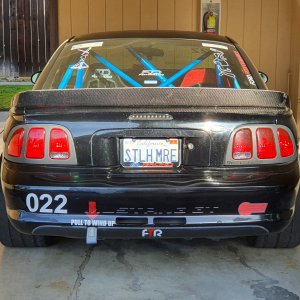Thomas_W
Well-Known Member

the continues are of wants!
after the mold is done, its pretty simple.
1. Spli mold
2. Wash mold with dish soap and green scotch bright sponge to remove wax abd pva
3. Wet sand and polish as necessary
4. Apply mold release to mold (this can vary depending on if you are using a wax/pva, semi-perm, or other style of release)
Then you get to make the parts
option 1- hand layup
option 2- vacuum bagged
option 3- vacuum infusion
option 4- prepreg
those are all in order from cheapest to OMG |*|^}€\+,%. Thats +|^,€}+|^|€. EXPENSIVE!
hand layups produce the heaviest and weakest parts (its dependent on the persons experience, but they are still heavier and weaker compared to the other 3 options) due to the excess of resin and lack of compression of the fabric.
Vacuum bagging is much more expensive due to the need of a vacuum pump, reservoir, vacuum bag, fittings, etc etc etc. this does produce a lighter, stronger and a more void free part. The decreased weight and increased strenght is due to the pressue applied by the vacuum. The layup is first done with a hand layup, then you place peel ply, perforated release film and a breather fabric down. This allows the entire layup to be affected by the vacuum, during which the vacuum sucks out any excess resin from the layup through the peel ply and perf. release film into the breather fabric. Once cured, the breather fabric, perf. release and peel ply is thrown away (the perf. plastic can sometimes be re-used). The breather is what soaks up the excess resin so it doesn't get sucked out of the back into your vacuum line and vacuum pump. So that is how the laminate weight is reduced.
The Laminate strength is increased due to two reasons. One is the lack of excess resin, it only adds weight once the layup is fully saturated, the second is due to the compaction from the vacuum which flattens out the individual strands of the fabric. Every time the fabric makes a bend to go over/under the piece of fabric running perpendicular to that one, the strength decreases.
Vacuum bagging also allows you to do a vacuum Sandwich style layup. This is when you substitute layers of fabric for a "core" material. This core material can be honeycomb, specialty foams, wood, etc. This produces Insanely strong parts for a weight Loss when you compare a similar solid layup of comparable strength to a sandwich part. The strength of a composite comes from the separation distance between the fabric layers. So with with two layups identically done, but one with a 1/8" piece of foam in between then layups and the other with a 1/4" piece of foam, the 1/4" piece will be substantially stronger, which means you can effectively Reduce the weight of the fabric layers in the layup to reduce the weight. Obviously there is a point where other things suffer (such as surface durability) so its a process that takes experimentation to find a layup that will work exactly how you want.
Then there is Vacuum Infusion. This is really AWESOME to watch, but VERY easy to get wrong and ruin hundreds of $$$$ worth of materials. You also can't use the traditional wax/pva method which is very cheap, you need a semi-permanent mold release (which is about $150 just to get started with).
With vacuum infusion, you apply your semi-permanent mold release ( I actually use this method for All layups in a mold as it saves all the effort of waxing and polishing). You then use a specialty spray adhesive that is low tack to apply your fabric layers Dry into the mold. This spray adhesive is why you can't use PVA. PVA is a liquid that cures into a film sort of like plastic wrap. If you tear that film prior or during your layup, you risk the chance in your part sticking in your mold, semi-perm releases are around to prevent that. So anyways, with that "film" if you apply the spray adhesive and you have to reposition the fabric, you'll peel the pva layer off and tear it, making you have to start all over. Once you get your layup into the mold "dry" you can either use a core material designed for resin infusion (Soric, grooved Airex, etc) or you can just do a non sandwich construction. For a sandwich construction, you do just like you would for vacuum bagging, but you don't use resin. For non sandwich you put it all in like vacuum bagging minus the resin and core material. Once you get your layup done, you spray adhesive in the peel ply to the layup. You then lay a specialty resin flow media (it looks like plastic oversize screen door mesh). Then you use spiral wrap tubing and plastic "T" fittings to route your resin feed lines. If these resin feed lines aren't in the proper location to full wet out the entire layup, your layup will be trash when infused and removed from the mold. Unfortunately, you don't know if they are in the proper space until you infuse the part!
Once your resin feed lines are routed, you have to route the vacuum line, this encompass' the entire part all the way around on the mold flanges. you also need a T fitting in this line as well.
The entire thing gets put into a vacuum bagged and the bag sealed. The T fittings from the Vacuum line and resin feed lines are then poked through the bag and sealed to the bag, ensuring enough slack is in the bag to reach all of the low spots of the part (the bag wont stretch, and you can't use the stretchy vacuum bagging film b/c it doesn't hold as much vacuum as traditional vacuum bagging film).
Now, the resin feed lines are clamped shut and the vacuum line is fed to a resin catch pot. This catch pot is between the mold and the vacuum pump as you'll have excess resin getting sucked out of the layup and it needs somewhere to go other than the vacuum pump.
The layup is then sucked down to as much vacuum as you can get (My rotary vane pump gets down to 25" of vacuum) and it sits for a minimum of 2 hours. This helps boil out any moisture that may be in the layup and allows you time to find and seal any vacuum leaks.
Now you can mix up your specialty resin for vacuum infusion (its like water when mixed). The central most resin feed line has its end put in your pot of resin and then it is unclamped. The resin then gets pushed into the layup and spreads out. Once it reaches your next resin feed line path in the mold, you can clamp off the first one, then repeat for the next ones. You do this until the part is fully wet out, then you clamp all the feed lines shut and allow the resin to suck into the catch pot and then cure.
You HAVE to have a BIG vacuum pump and reservoir to get the most out of vacuum infusion. My pump is 10CFM rotary valve ($1800 new) and i have it on a 20 gallon air compressor tank for a reservoir. You have to have this large of a pump so if you develop a leak mid infusion, you can fix it and the bag can get back to vacuum as quickly as possible, otherwise you risk ruining the part.
Lastly you have Pre-preg's. I'm not going to talk much about them as they are EXPENSIVE! These are typically "frozen" as they already have the proper resin in the fabric, so they have to stay cold to keep from curing. They also require specific temps, ramp rates, cool down rates and other things to get the most of them. IE, its unrealistic to use them as a hobbyist.










